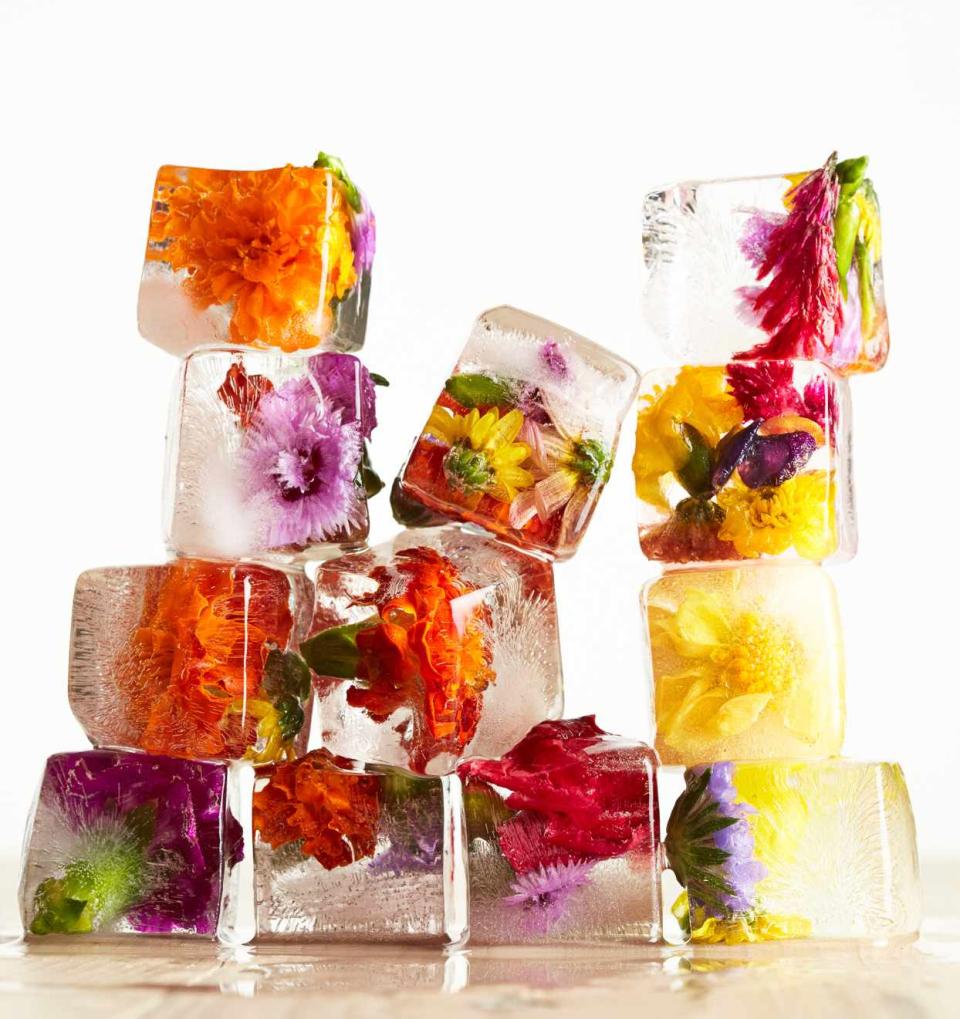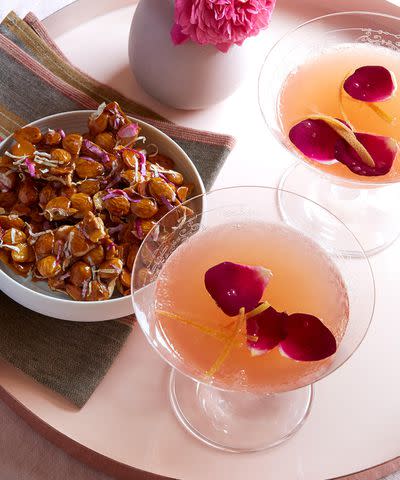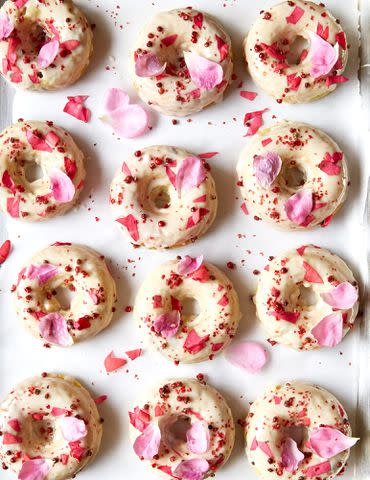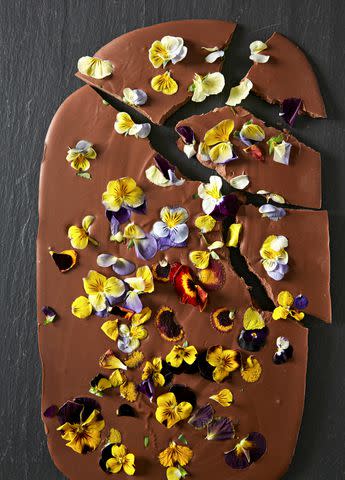Edible Flowers Are Having a Moment—Here’s What to Know About the Trend
Pretty, edible flowers are blossoming on cakes, in cocktails, and even on savory dishes such as pasta and salads—and garden and food experts alike are fans.

One of the most exciting and interesting culinary trends coming up the pipeline for 2023 and beyond is the use of edible flowers in recipes for everything from salads to pastas to cocktails and cakes. Flower farmers are now growing their own delicious flowers and herbs to sell to local restaurants and bakeries, who then creatively use the blossoms in innovative ways, appealing to a new generation of consumers who are increasingly interested in plant-based diets.
Why not add nasturtium petals as garnishes to desserts instead of straight sugar? The taste is similar enough to mimic sugary sweetness, but healthier.
The popularity of edible flowers was recognized early last year by blog Chef Club, which said that 2022 was the year of edible flowers.
“With an average of 107k queries typed each month into Google worldwide, the term ‘edible flowers’ doubled compared to 2019,” Chef Club’s post says. “Local producers are making the choice to grow edible flowers, feeding a local market that respects the ecosystem and the seasons. It must be said that the field of possibilities is vast, very vast. Fresh flowers can be used to decorate both sweet and savory dishes. Imprisoned in an ice cube, they enhance cocktails. Dried, they can be used in infusions, jams, breads, and sauces. Gelled, they become edible works of art. Pressed or crystallized, they give relief to pastries. What about making them a distinctive signature?”
The edible flowers craze caught up more broadly in the U.S. this year, with Transparency Market Research, The Slow Flowers Movement, and Technavio Market Research Reports all claiming that in 2023 and for a few years moving forward, the popularity of edible flowers will increase dramatically.
For the home gardener and floral enthusiast, there are more ways to enjoy your harvest than just arranging flowers in vases throughout your home. Now, you can add certain blooms to drinks and meals, making your food not only tasty, but also more visually appealing.

The Best Flowers to Eat
Debra Prinzing, author, podcaster, and founder of the Slow Flowers movement, which focuses on celebrating America-grown flower farmers, says that there are many flowers we can eat that both taste and look good. Borage, nasturtium, violas, dahlias, geraniums, marigolds, dianthus, and calendulas are some of the ones that Prinzing suggests trying in your own meals and drinks.
“There’s so many more flowers that are edible than people realize,” Prinzing tells Better Homes & Gardens. “You can use these varieties to decorate a cake or to put in a fancy drink or to put in a salad or even to put in on the top of a pasta dish. It’s just really become evident to us that consumers are interested, and for anyone in the floral industry, it’s a huge opportunity to have a new category of what you grow and how you sell it.”

Benefits of Eating Flowers
Each flower comes with its own flavor profile and nutritional benefit. Caitlin Mathes of The Marigold Gardens in Ithaca, New York, eats her marigolds regularly, saying that their taste is quite bitter and helps with digestion, circulation, and skin issues. Mathes’s farm includes 40 different varieties of marigolds, which she regularly sells to bakers and restaurants for their own culinary use. And eating marigolds isn’t just a current trend: For centuries, the flower has been referred to as the “poor man’s saffron” and has been used in spiritual practices, such as Día de los Muertos each November.
“If you want to help your digestion, [marigolds are] a warming herb. It’s mentioned with circulation and skin [issues],” Mathes says. “I wouldn’t eat a ton of it because the flavor wouldn’t appeal to me so much, with any herb you wouldn't want to eat like a ton of it. [It’s been used] historically, in different celebrations. It has a lot to do with moving through stages of life, with Día de los Muertos, to connect with people in the afterlife.”
In terms of the benefits of eating other types of flowers, Mount Sinai hospital says that calendula is often used topically, improving skin hydration and increasing blood flow and oxygen to help wounds heal. Nasturtium and pansies are also traditionally associated with alleviating certain symptoms and ailments.
Warning
While many plants are beneficial to humans, flowers like lilies, hellebores, foxglove, and delphinium are toxic and should not be consumed.

Edible Flower Recipe Ideas
Bethany Dixon of Pies and Pinups in Ithaca, New York, has been working with edible flowers since her start seven years ago, creating cakes and other concoctions with flowers from local farms like Mathes’s marigold farm. She recommends starting with pansies and nasturtiums, which, according to her, taste “peppery, bright, and citrusy.”
Adding chopped nasturtium petals to a plate with goat cheese and honey will surely be delicious and is a great entry point into using edible flowers in other meals and bakes, Dixon says. Her cakes feature fresh blooms as toppings, using marigolds, pansies, and more to make the creations look and taste amazing.
“I haven’t yet encountered people who sort of are already really aware of the options and really interested in specific ones. But it definitely is a trend across customers,” Dixon says. “I feel like there’s this whole new generation of pastry chefs who are using foraged and edible ingredients. People are really excited and wanting that exuberant edible flower situation as opposed to the more traditional and more streamlined flower things. I think the more chaotic and joyful it looks, the more people are interested, and that’s really interesting.”
Some other great ways to include edible flowers in your diet include freezing them in ice cubes or adding them to lollipops, which is something that Sarah Wagstaff of SUOT Farm and Flowers did with baker Darcy Olsen of Fir Island Cakery. Wagstaff says the resulting lollipops are beautiful and tasty, with real pansy petals infused inside the dessert.
Whether you’re cooking, baking, or drinking edible flowers, the sky’s the limit.
“We eat with our eyes first, right?” Wagstaff says. “And so of course chefs are going to make their plating really beautiful. But if you can add any sort of beauty to the actual ingredients, of course, why wouldn't you? So using flowers is just fun and delightful. And I think it really adds to the texture and flavor profiles or the color of whatever dish you're serving.”
Related: Why Nature-Inspired Desserts Are Sprouting on Menus Across the Country
For more Better Homes & Gardens news, make sure to sign up for our newsletter!
Read the original article on Better Homes & Gardens.

